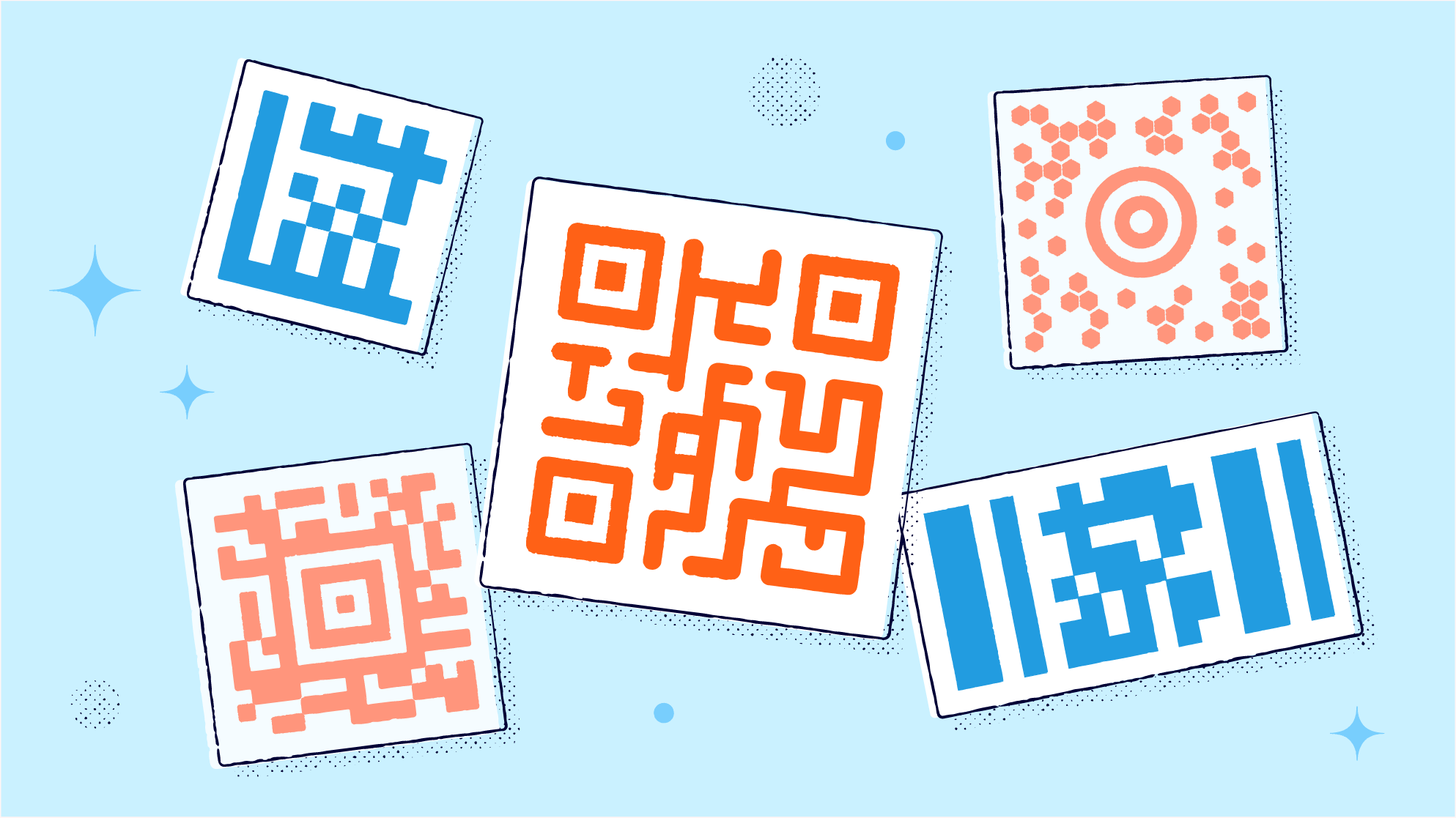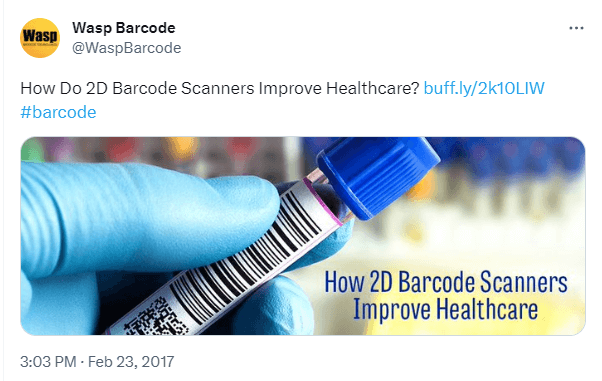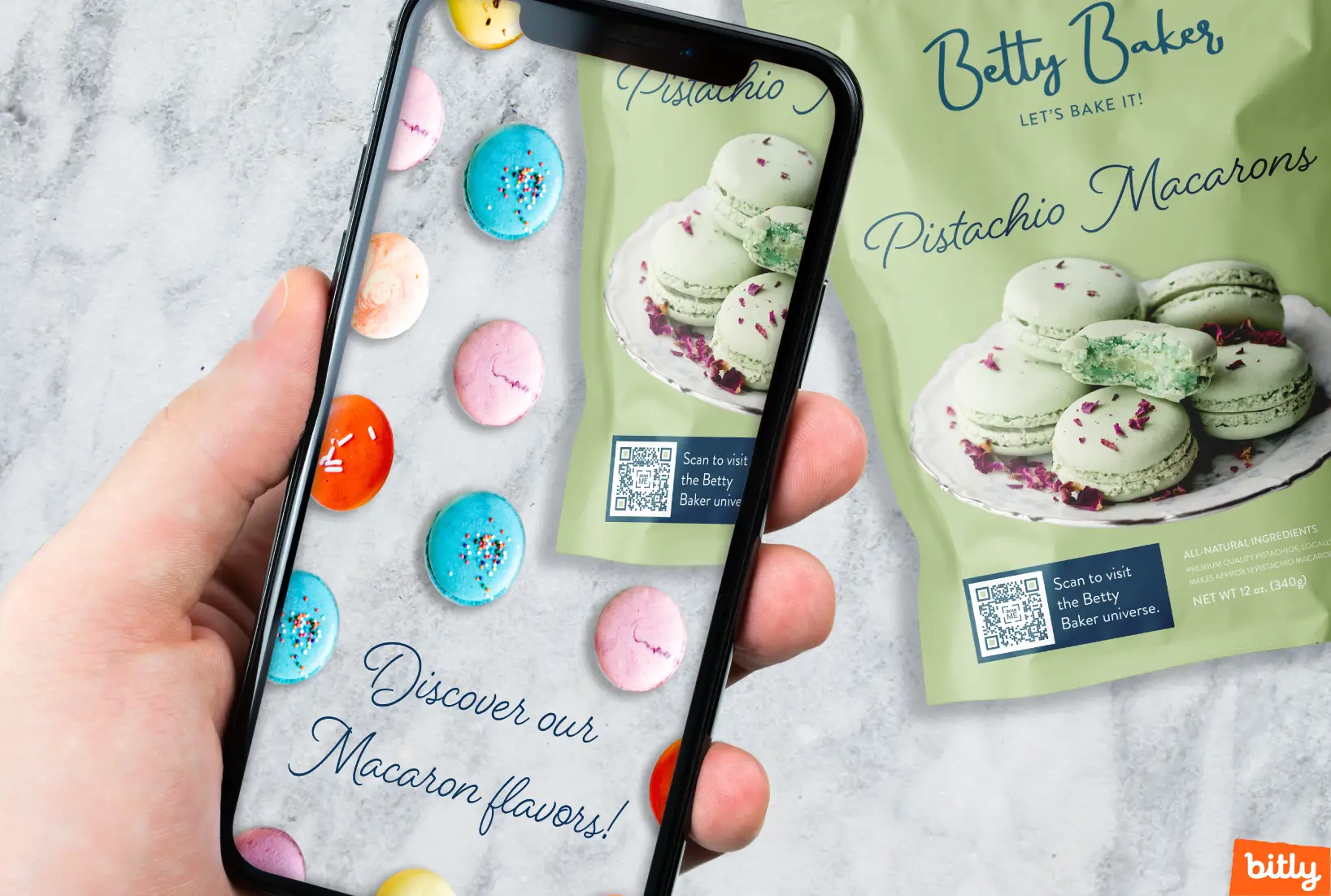
2D barcodes are planting their flags in industries far and wide, from retail and consumer packaged goods to healthcare and pharmaceuticals. Are you wondering how this could impact your industry? In this article, we break down all the perks of 2D barcodes, examples, use cases, and more!
What is a 2D barcode?
A 2D barcode is a type of barcode that contains information within its horizontal and vertical structure, offering greater data capacity than 1D barcodes (up to 7,089 characters). Two-dimensional barcodes can come in various patterns and colors that range from black and white to customized color combinations. Examples of 2D barcodes include QR Codes, data matrix codes, and PDF417.
Examples of 2D barcodes
QR Code
Quick-response codes, or QR Codes, are a type of two-dimensional barcode that stores up to 4,296 characters or 7,089 digits. With its square appearance, it’s a complex matrix that consists of position detection markers, alignment markers (located in the three corners), black and white modules defining the timing pattern, data correction keys to account for scanning errors, and a quiet zone. All of these components work together to make the Code easier to scan despite its complexity.
Learn about the different uses across industries and how to create your very own Bitly QR Codes.
Data matrix code
A data matrix code is a 2D square-shaped code that can store up to 2,335 alphanumeric characters. It’s recognizable by its black-and-white Tetris-looking appearance, making it readable for scanning. With a 30% error correction, a third of the matrix code can still be scanned even if it is damaged. It’s often used to label parts in aerospace, automotive, electronics, and manufacturing industries.
PDF417
A PDF417 is a rectangular-shaped black and white 2D barcode that encodes 100 to 200 characters within one symbol. PDF417 is called a stacked linear symbology because it visually resembles multiple layers of barcodes stacked on top of each other.
The structure comprises the following elements: start pattern, stop pattern, left row indicator, data codewords, right row indicator, left row indicator, data codewords, and the quiet zone. The data code words, which are located in the center of the barcode, contain all the stored data.
These rectangular codes are used in the automotive industry, transportation industry for shipping labels, and identification cards such as passports and licenses.
Aztec code
Aztec codes are a black-and-white square with 32 layers of patterns and pixels of varying sizes. The code can store up to 3,067 alphanumeric characters and has an error correction of 23%. The square in the middle of the barcode actually looks like a bird’s eye view of an Aztec pyramid, giving it its name.
These codes are commonplace in the transportation industry, typically used as electronic boarding passes and tickets for flights, trains, and other travel documents. They can also be used on invoices and car registration documents.
Maxicode
A maxicode, also known as UPS (United Parcel Service) code or Bird’s Eye code, is a fixed one-inch squared two-dimensional barcode. The square has a bullseye in the middle and is surrounded by offset rows of hexagon modules. Originally created for UPS tracking on shipping labels, the maxicode can hold 93 characters of data, including a postal code, country code, class service number, and other address data.
GS1 Composite code
GS1 Composite Codes are unique codes that contain characteristics of both linear 1D barcodes and 2D barcodes. The 1D part encodes the item’s primary identification data and the 2D part comprises other data such as a batch number or expiration data. There are three variations of the GS1 composite code that extend the barcode with PDF417 codes.
GS1 maintains guidelines for 2D barcodes internationally, decreasing the difficulty of sharing information across companies and countries by setting the global standard.
Learn more about GS1 barcodes.
4 industry-based 2D barcode use cases
In the examples below, we highlight some industries that are beginning to take full advantage of 2D barcodes.
Note: These examples were found during our online research while writing this article.
1. Healthcare and pharmaceutical
2D barcodes are making a tremendous difference in the pharmaceutical and healthcare industries. From improving medicine delivery and assisting medical staff with medical identification, to preventing fatal medical errors that are saving lives, 2D barcoding is doing wonders for these industries. To top it off, using this tech also helps hospitals save on resources, making the investment in two-dimensional barcodes worth every dollar.
Did you know that 44,000 to 98,000 deaths are caused by medical mistakes in hospitals, with 7,000 related to medication errors? 2D barcode technology can help prevent such catastrophic missteps with medication and patient identification labels.
One hospital, Clark Memorial, has begun implementing 2D barcode technology with Wasp Barcode’s Wasp Labeler + 2D Barcode Labeling Software. Using this product, the hospital created its own 2D barcodes to use on-site. Take a look at the example below to see how they label their medication, equipment, and containers to protect patients.

2. Retail
The retail industry is slowly beginning to pivot towards 2D barcodes. One of the front runners in the retail industry is Woolworths Australia, who, in 2017 began rolling out GS1-compliant 2D barcodes on their fresh produce and cold products.
One great advantage of replacing a 1D barcode with a 2D barcode is the ability to encode more information about the product. In the past, the 1D barcode was solely for the retailer’s benefit, but now 2D barcodes involve the consumer as well. Customers can use their smartphones to scan the same code used at point-of-sale to learn more about the product.
From the customer’s perspective, it brings more transparency to the products, making it easier for them to make informed choices. Not only that, it creates better brand engagement, allowing customers to connect more deeply with the products they love.
The staff reaps the benefits, too! They can efficiently manage store inventory and stay informed about details like sell-by dates. And here’s the cherry on top: Woolworths gets to reduce food waste on a grand scale. In short, replacing a regular barcode with a two-dimensional barcode can create a positive ripple for the supplier, the retailer, and trickling down to the customer.
3. Consumer packaged goods
The consumer packaged goods (CPG) industry has also embraced the 2D barcode, around the time of QR Code resurgence. As customers increasingly demand greater brand transparency, this development represents a positive step in the right direction. It reflects a consumer response to the growing desire for more openness and honesty from brands. In fact, GS1 has plans to help retailers transition to 2D barcodes by 2027.
By utilizing the 2D barcode, companies can enhance their labeling systems and provide customers with comprehensive product information. This includes details about the supply chain, ingredient sourcing, and sustainability practices.
But companies can also leverage 2D barcode technology as a vital component of their omnichannel strategy. This enables customers to establish a direct line of communication with the brand, creating seamless connections. Through these barcodes, brands can enhance their branding efforts by linking consumers to marketing channels such as social media or smartly promoting their products through coupons and loyalty programs.
For more information on how to implement 2D barcode tech on your products, read how you can use a product QR Code on your packaging.

Bitly and GS1
As Bitly QR Code creations in the consumer packaged goods industry have surged by 88% year-over-year, we recognize the importance of standards in the QR Code space.
Read our announcement about our increased investment in powering connections by supporting the implementation of GS1 Standards in our products.
4. Warehouse and logistics
While barcodes have long been used in warehouse management, the booming e-commerce industry has outpaced the capabilities of 1D barcodes. That’s where 2D barcodes come in. They offer a smart, efficient, and accurate solution for warehouse logistics. With 2D barcodes, companies can effectively manage their warehouses and keep up with the growing demands of e-commerce.
The plus side of two-dimensional barcodes is that they can store a wealth of data and are quicker to scan. This enables them to include information like serial numbers, shipping dates, expiration dates for food and medication, and much more.
The best part? Just one quick scan provides all the information you need about a product. If you’re aiming to boost productivity and enhance inventory accuracy, this is the way to go!
Advantages of a 2D barcode
High correction levels
Unlike 1D barcodes that offer no error correction, 2D barcodes are designed with error correction capabilities. Even if the code gets damaged up to a certain extent, they remain readable. This is achieved through four error correction levels, ranging from as low as 7% to as high as 30%.
Speedy and accurate
The vertical and horizontal structure of 2D barcodes enables easy scanning, enhancing efficiency in warehouse management. For instance, conveyor belts can read these codes at lightning-fast speeds, improving the overall performance of the warehouse.
Versatile
In contrast to linear barcodes that require dedicated scanners, 2D barcodes can be read by most modern smartphones, including Android and iOS devices. Simply point your smartphone camera at the barcode, and it will scan and retrieve the information from the code.
This versatility is very useful for any up-and-coming business that wants to employ modern marketing tactics, inventory management, and customer experiences. Discover how QR Codes for small businesses can help you grow.
Stores plenty of data
While 1D barcodes are very limited in their data storage, some 2D barcodes can store up to 7,089 characters. This makes it possible to store a variety of data such as URLs, contact information, and even rich multimedia content like images and audio files on a single code.
Marketing campaign tools
Got a marketing campaign you want to launch? Using 2D barcoding software like a QR Code can help brands launch creative mobile marketing campaigns that increase customer engagement. Plus, QR Codes are trackable, so brands can measure how successful their campaigns have been and use the data to improve their future campaigns. They offer a simple means to reach new customers, engage existing customers, and build loyalty.
Leverage the Bitly Connections Platform for 2D barcodes
Your own two-dimensional square—using the Bitly QR Code Generator—can be created on the Bitly Connections Platform. Customize your QR Code to match your brand with colors, shapes, and logos, and get access to in-depth tracking information for more insights into each Code’s performance. Whether your goal is to enhance brand transparency, entice customers to sign up for your newsletter, or connect people to your social media platform, you’ll be one step closer to making it happen.
Get started today with a free account and tip your toes in the QR Code pool!